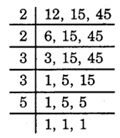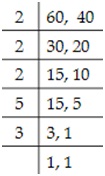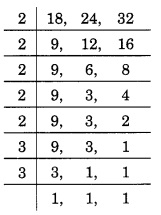ANSWER KEY -
Multiple Choice questions:
1. C. Composite numbers
2. A. Even
3. D. 425
Explanation: 425, a number is divisible by 5 if its unit’s digit is either 0 or 5.
4. B. 4
Explanation: 4,
2 × 2 × 3
HCF = 2 × 2 = 4
40 = 2 × 2 × 2 × 5
5. C. multiple
6. A. 1
7. B. 180
Explanation: 180

LCM = 2 × 2 × 3 × 3 × 5 = 180
8. D. 9
9. A. 2
10. D. 0
11. C. 11
Explanation: 10 + 40 ÷ 8 × 2 – 9 = 10 + 5 × 2 – 9 = 10 + 10 – 9 = 20 – 9 = 11 (BODMAS Rule)
12. A. 135
Explanation: 135, 1 + 3 + 5 = 9 which is divisible by 3 therefore no. is divisible
13. C. 2
14. B. 72
15. D. has exactly two factors
Explanation: Exactly two factors are 1 and the number itself.
Match The Following:

Fill in the blanks:
1. 1 is neither prime number nor composite number.
2. The smallest prime number is 2.
3. The smallest composite number is 4.
4. The smallest even number is 2.
True /False:
1. True
2. False
3. True
4. False
Very Short Answer:
1.

LCM = 23 × 3 × 5 = 120
2. 27 = 1 × 27
27 = 3 × 9
Thus, all the factors of 27 are 1, 3, 9 and 27.
3. By checking all the numbers from 125 to 142 which are divisible by 7, we get 126, 133, 140.
So, the multiples of 7 that lie between 125 to 142 are 126, 133 and 140.
4. Factors of 70 are 1, 2, 5, 7, 10, 14, 35 and 70.
Factors of 105 are 1, 3, 5, 7, 15, 21, 35 and 105.
Factors of 175 are 1, 5, 7, 25, 35 and 175.
∴ Common factors of 70, 105 and 175 are 1,5,7 and 35.
Highest of these common factors is 35.
∴ H.C.F of 70, 105 and 175 is 35.
5. Factors of 27 are 1, 3, 9 and 27.
Factors of 63 are 1, 3, 7, 9, 21 and 63.
∴ Common factors of 27 and 63 are 1, 3 and 9.
Highest of these common factors is 9.
∴ H.C.F. of 27 and 63 is 9.
6. The multiples of 9 are:
9 × 1 = 9, 9 × 2 = 18, 9 × 3 = 27, 9 × 4 = 36, 9 × 5 = 45, 9 × 6 = 54, 9 × 7 = 63, 9 × 8
= 72, 9 × 9 = 81, 9 × 10 = 90, 9 × 11 = 99, 9 × 12 = 108
Since 108 is greater than 100 therefore all the multiples of 9 upto 100 are
9, 18, 27, 36, 45, 54, 63, 72, 81, 90 and 99.
7. The smallest 4-digit number is 1000.
The least number which is exactly divisible by 8, 10, and 12 will be their L.C.M.
L.C.M. of 8, 10, and 12:

L.C.M. of 8, 10, 12 = 2 × 2 × 2 × 5 × 3 = 120.
By dividing smallest 4-digit number 1000 by 120,

We find that 1000 is not exactly divisible by 120.
If we subtract 40 from 1000, we get 1000 - 40 = 960, which will be divisible by 120.
But 960 is a 3-digit number.
The next number to 960 which is divisible by 120 is 960 + 120 = 1080.
Therefore, the required 4-digit number divisible by 8, 10, and 12 is 1080.
8. (a) The sum of any two even numbers is even.
Example: 4 (even) + 6 (even) = 10 (even)
(b) The sum of any two odd numbers is even.
Example: 5 (odd) + 7 (odd) = 12 (even)
9. (a) Given number = 1212
Sum of the digits = 1 + 2 + 1 + 2 = 6, which is divisible by 3.
Hence, 1212 is also divisible by 3.
(b) Given number = 625
Sum of the digits = 6 + 2 + 5 = 13, which is not divisible by 3.
Hence, 625 is not divisible by 3.
10. We know that the product of the number = LCM × HCF = 15 × 4 = 60
Hence, the product of the given numbers = 60
11. Given numbers are 5 and 7. We observe that 5 and 7 are co-prime numbers.
Hence, the HCF is 1.
12. We have 25 × 1 = 25; 25 × 2 = 50; 25 × 3 = 75
Hence, the required multiples are 25, 50 and 75.
13. (a) Possible factors of 12 are:
12 = 1 × 12; 12 = 2 × 6; 12 = 3 × 4
Hence, the factors of 12 are 1, 2, 3, 4, 6 and 12.
(b) Possible factors of 18 are:
18 = 1 × 18; 18 = 2 × 9; 18 = 3 × 6
Hence, the factors of 18 are 1, 2, 3, 6, 9 and 18.
14. First three multiples of 11 are:
11 x 1 = 11; 11 x 2 = 22; 11 x 3 = 33
Hence, the required multiples are: 11,22 and 33.
15. Pairs of twin prime numbers are: (3, 5), (5, 7), (11, 13), (17, 19).
Short Answer:
1. Given that: 32 + 96 ÷ (7 + 9)
= 32 + 96 ÷ 16 (Using BODMAS)
= 32 + 6 = 38
2. Given that: 18 + {1 + (5 – 3) × 5} (Using BODMAS)
= 18 + {1 + 2 × 5} = 18 + {1 + 10}
= 18 + 11 = 29.
3. Here 1,10,011 = 1,10,000 + 11
= 11 × 10,000 + 11 × 1
= 11 × (10,000 + 1)
= 11 × 10,001
It is clear that 11 is a factor of 11 × 10,001.
4. Hence, 11 is a factor of 1,10,011
The product of two numbers is 144.
∴ The possible factors are 1 × 144, 2 × 72, 3 × 48, 4 × 36, 6 × 24, 8 × 18, 9 × 16, 12 × 12
Here, we observe that out of these factors, we take 9 and 16.
Product = 9 × 16 = 144 and sum = 9 + 16 = 25
Hence, the required numbers are 9 and 16.
5. Sum of the digits at odd places = 6 + 1 + 8 = 15
Sum of the digits at even places = 3 + 0 = 3
Difference of the two sums = 15 – 3 = 12,
which is neither 0 nor the multiple of 11.
Hence, 80136 is not divisible by 11.
6. Given that: HCF = 6
LCM = 120
Let the two numbers be a and b, where a = 24, b = ?
We know that: a × b = HCF × LCM
⇒ 24 × b = 6 × 120
⇒ b = 6 × 12024
⇒ b = 30
Hence, the other number is 30.
7. Given numbers are 12 and 30
12 = 2 × 2 × 3;
30 = 2 × 3 × 5
∴ LCM = 2 × 2 × 3 × 5 = 60
Hence, the LCM of 12 and 30 = 60.
8. Given numbers are 18, 24 and 32, we have

Thus, LCM = 2 × 2 × 2 × 2 × 2 × 3 × 3 = 288
The smallest 4-digit number = 1000
Now, we write multiples of 288, till we get a 4-digit number.
288 × 1 = 288, 288 × 2 = 576,
288 × 3 = 864, 288 × 4 = 1152
Hence, 1152 is the required number.
9. Given numbers are 82 and 132 and the remainders are 1 and 6 respectively.
We have, 82 – 1 = 81 and 132 – 6 = 126
So, we need to find the HCF of 81 and 126

Common factor is 3 (occurring twice).
∴ HCF = 3 × 3 = 9
10. Hence, the required number is 9.
Given numbers are 455, 582 and 710 and the respective remainders are 14, 15 and 17.
We have 455 – 14 = 441, 582 – 15 = 567 and 710 – 17 = 693.
Now let us find their HCF.

Common factors are 3 and 7.
∴ HCF = 3 × 7 = 21
Hence, the required number is 21.
Long Answer:
1. Using BODMAS Rule, we have
40 + [20 – {28 ÷ 7 – 3 + (30 – 5 of 4)}]
= 40 + [20 – {28 ÷ 7 – 3 + (30 – 20)}]
= 40 + [20 – {28 ÷ 7 – 3 + 10}]
= 40 + [20 – [4 – 3 + 10}]
= 40 + [20-11] = 40 + 9 = 49.
2. To arrange the books in the required way,
we have to find the greatest number that divides 336, 192 and 144 exactly.
So, HCF of 336, 192 and 144 is

Common factors are 2 × 2 × 2 × 2 × 3 = 48
∴ HCF = 48, i.e., each stack contains 48 books.
∴ Number of stacks of English books = 336 + 48 = 7
Number of stacks of Hindi books = 192 4 - 48 = 4
Number of stacks of Urdu books = 144 4 - 48 = 3
3. We have
Number of cows = 111
Number of sheep = 185
Number of goats = 296
According to the condition of the boatsman, we need to find HCF of 111, 185 and 296
111 = 3 × 37;
185 = 5 × 37;
296 = 2 × 2 × 2 × 37
∴ the HCF = 37
So, the number of animals of same kind = 37.
Number of trips
=111/37 + 185/37 + 296/37
= 3 + 5 + 8 = 16
Hence, the number of animals in each trip = 37
and the number of trips = 16
4. The number of participants in each room must be the HCF of 60, 96 and 144.
∴ 60 = 2 × 2 × 3 × 5
96 = 2 × 2 × 2 × 2 × 2 × 3
144 = 2 × 2 × 2 × 2 × 3 × 3
HCF = 2 × 2 × 3 = 12
Number of rooms required
= 6012 + 9612 + 14412
= 5 + 8 + 12 = 25
Hence, number of participants = 12
in each room and number of rooms required = 25.
Assertion and Reason Answers:
(1) (a) Both A and R are true and R is the correct explanation of A
(2) (a) Both A and R are true and R is the correct explanation of A